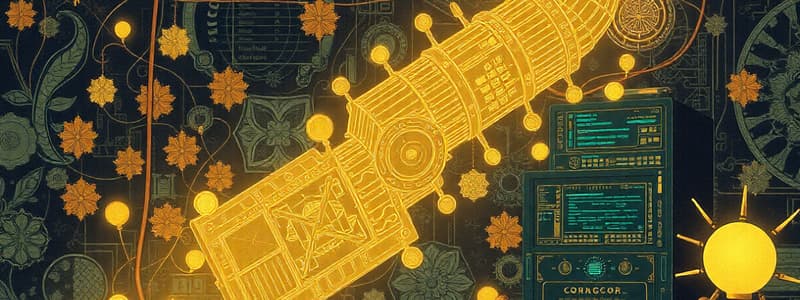Podcast
Questions and Answers
Who is known as the father of modern computers?
Who is known as the father of modern computers?
- Steve Jobs
- Bill Gates
- Alan Turing
- Charles Babbage (correct)
Information refers to the raw facts that need to be processed by a computer.
Information refers to the raw facts that need to be processed by a computer.
False (B)
What are the two main forms of data flow in a computer system?
What are the two main forms of data flow in a computer system?
Input and Output
The processed form of data is referred to as __________.
The processed form of data is referred to as __________.
Match the components of a computer with their functions:
Match the components of a computer with their functions:
What is the primary function of a computer?
What is the primary function of a computer?
Computers can operate independently without user instructions.
Computers can operate independently without user instructions.
Name the four basic functions of a computer system.
Name the four basic functions of a computer system.
The acronym IPO stands for Input, Process, and _____?
The acronym IPO stands for Input, Process, and _____?
Match the following functions with their descriptions:
Match the following functions with their descriptions:
Flashcards are hidden until you start studying
Study Notes
Introduction to Computers
- Computers are vital in various fields, from research to entertainment.
- The term "computer" originates from the Latin "computare," meaning "to compute."
- Computers process data based on instructions to produce output; they handle arithmetic and logical operations.
- The fundamental functions of a computer are input, process, output, and storage.
- The IPO cycle (Input → Process → Output) summarizes computer operation.
- Charles Babbage's Analytical Engine (1832) is considered a precursor to modern computers.
Data and Information
- Data represents raw, unprocessed facts.
- Information is processed data, the desired output.
- Data flow involves input (data and instructions), processing, and output (information).
Functional Components of a Computer System
- A computer system consists of input, memory, processing, output, and control units.
- The CPU (Central Processing Unit) is the brain of the computer, performing data processing operations and controlling other components.
- The CPU includes the ALU (Arithmetic Logic Unit), Memory Unit, and Control Unit.
Strengths of Computers
- Key strengths include reliability, modularity, efficiency, real-time processing, parallel processing, deterministic operation, portability, and communication capabilities. These features enable widespread use across diverse applications.
Characteristics of Computers
- Computers are characterized by high speed (measured in MHz and GHz), accuracy (GIGO principle applies), and the ability to perform complex tasks efficiently.
Input Unit
- Input devices allow data entry into the computer.
- Common input devices include keyboards, mice, trackballs, joysticks, light pens, touch panels, and scanners.
Central Processing Unit (CPU)
- The CPU performs data processing, stores data and instructions, and controls computer operations.
- The ALU performs arithmetic and logical operations.
- The Memory Unit (also called internal storage, main memory, or RAM) stores instructions, data, and intermediate results.
- RAM (Random Access Memory) is primary memory for program and data storage during execution.
- ROM (Read Only Memory) is secondary memory containing essential operating system instructions.
- The Control Unit manages and coordinates all computer units, transferring data and interpreting instructions.
Output Unit
- Output devices present information from the computer to users.
- Common output devices include monitors, printers, and speakers.
Key Features of Computers
- Computers exhibit diligence (consistent performance without fatigue), high storage capacity, versatility (handling diverse tasks), automation, multitasking, precision, entertainment capabilities, scalability, and increasing incorporation of Artificial Intelligence (AI).
Limitations of Computers
- Computers are dumb machines requiring human instructions; lack decision-making ability and natural learning capabilities (although AI is improving this).
- Other limitations include security vulnerabilities, lack of emotional intelligence, dependence on humans, physical constraints (speed, memory, storage), the need for power and maintenance.
Classification of Computers
- Computers are classified by working principle (analog, digital, hybrid), size (supercomputer, mainframe, minicomputer, microcomputer), and purpose (general-purpose, special-purpose).
Types of Computers Based on Working Principle
- Analog computers process continuous physical quantities (e.g., voltage).
- Digital computers process discrete numerical data.
- Hybrid computers combine analog and digital capabilities.
Types of Computers Based on Purpose
- General-purpose computers handle various tasks.
- Special-purpose computers are designed for specific tasks.
History of Computers
- Early computers focused on calculations; modern computers serve diverse purposes.
- Minicomputers connected multiple computers in offices.
- Mainframe computers offer high speed and storage, used by large organizations.
- Supercomputers, the most powerful, are used for demanding applications.
Differences between Analog and Digital Computers
- Analog computers measure, while digital computers count.
- Analog computers use continuous physical values; digital computers use discrete numbers (binary).
- Analog computers offer lower accuracy and speed, while digital computers provide higher accuracy and speed.
- Digital computers have greater memory and flexibility and wider applications than analog computers.
Computer Types Based on Size
- Microcomputers (PCs) are small, designed for individual use (laptops, tablets, smartphones).
- Minicomputers are more powerful than microcomputers.
- Mainframe computers are large, high-capacity systems used by large organizations.
- Supercomputers are the most powerful and are used for complex calculations.
Studying That Suits You
Use AI to generate personalized quizzes and flashcards to suit your learning preferences.




